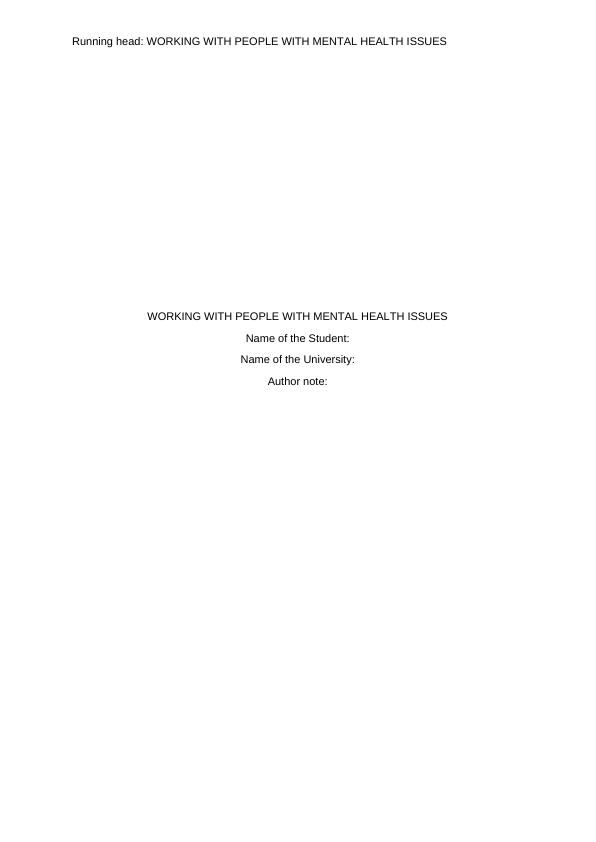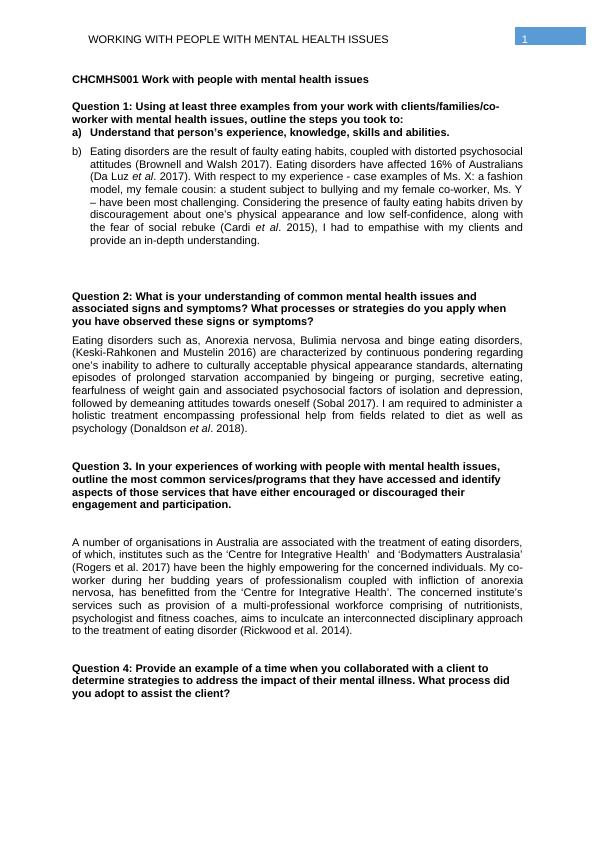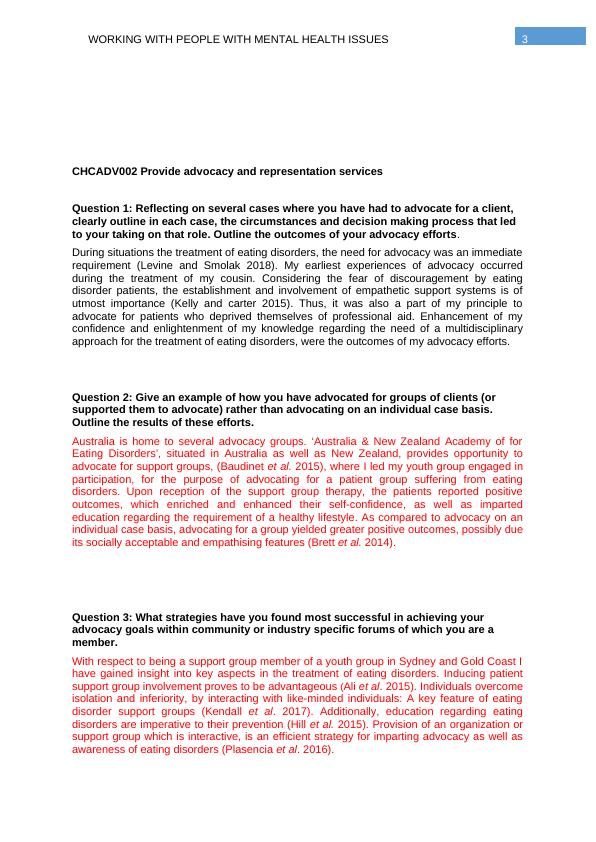Working with People with Mental Health Issues
Outline steps to understand client's experience, adjust communication style, understanding common mental health issues and associated signs and symptoms, common services/programs accessed by clients, and collaboration with clients to address the impact of their mental illness.
35 Pages11868 Words322 Views
Added on 2023-06-08
About This Document
This article discusses the steps to work with people with mental health issues, including understanding their experience, knowledge, skills, and abilities. It also covers common mental health issues and associated signs and symptoms, as well as the most common services/programs that people with mental health issues access. Additionally, it provides insights on advocacy and representation services, assessment of co-existing needs, and developing service programs.
Working with People with Mental Health Issues
Outline steps to understand client's experience, adjust communication style, understanding common mental health issues and associated signs and symptoms, common services/programs accessed by clients, and collaboration with clients to address the impact of their mental illness.
Added on 2023-06-08
ShareRelated Documents
Running head: WORKING WITH PEOPLE WITH MENTAL HEALTH ISSUES
WORKING WITH PEOPLE WITH MENTAL HEALTH ISSUES
Name of the Student:
Name of the University:
Author note:
WORKING WITH PEOPLE WITH MENTAL HEALTH ISSUES
Name of the Student:
Name of the University:
Author note:

1WORKING WITH PEOPLE WITH MENTAL HEALTH ISSUES
CHCMHS001 Work with people with mental health issues
Question 1: Using at least three examples from your work with clients/families/co-
worker with mental health issues, outline the steps you took to:
a) Understand that person’s experience, knowledge, skills and abilities.
b) Eating disorders are the result of faulty eating habits, coupled with distorted psychosocial
attitudes (Brownell and Walsh 2017). Eating disorders have affected 16% of Australians
(Da Luz et al. 2017). With respect to my experience - case examples of Ms. X: a fashion
model, my female cousin: a student subject to bullying and my female co-worker, Ms. Y
– have been most challenging. Considering the presence of faulty eating habits driven by
discouragement about one’s physical appearance and low self-confidence, along with
the fear of social rebuke (Cardi et al. 2015), I had to empathise with my clients and
provide an in-depth understanding.
Question 2: What is your understanding of common mental health issues and
associated signs and symptoms? What processes or strategies do you apply when
you have observed these signs or symptoms?
Eating disorders such as, Anorexia nervosa, Bulimia nervosa and binge eating disorders,
(Keski-Rahkonen and Mustelin 2016) are characterized by continuous pondering regarding
one’s inability to adhere to culturally acceptable physical appearance standards, alternating
episodes of prolonged starvation accompanied by bingeing or purging, secretive eating,
fearfulness of weight gain and associated psychosocial factors of isolation and depression,
followed by demeaning attitudes towards oneself (Sobal 2017). I am required to administer a
holistic treatment encompassing professional help from fields related to diet as well as
psychology (Donaldson et al. 2018).
Question 3. In your experiences of working with people with mental health issues,
outline the most common services/programs that they have accessed and identify
aspects of those services that have either encouraged or discouraged their
engagement and participation.
A number of organisations in Australia are associated with the treatment of eating disorders,
of which, institutes such as the ‘Centre for Integrative Health’ and ‘Bodymatters Australasia’
(Rogers et al. 2017) have been the highly empowering for the concerned individuals. My co-
worker during her budding years of professionalism coupled with infliction of anorexia
nervosa, has benefitted from the ‘Centre for Integrative Health’. The concerned institute’s
services such as provision of a multi-professional workforce comprising of nutritionists,
psychologist and fitness coaches, aims to inculcate an interconnected disciplinary approach
to the treatment of eating disorder (Rickwood et al. 2014).
Question 4: Provide an example of a time when you collaborated with a client to
determine strategies to address the impact of their mental illness. What process did
you adopt to assist the client?
CHCMHS001 Work with people with mental health issues
Question 1: Using at least three examples from your work with clients/families/co-
worker with mental health issues, outline the steps you took to:
a) Understand that person’s experience, knowledge, skills and abilities.
b) Eating disorders are the result of faulty eating habits, coupled with distorted psychosocial
attitudes (Brownell and Walsh 2017). Eating disorders have affected 16% of Australians
(Da Luz et al. 2017). With respect to my experience - case examples of Ms. X: a fashion
model, my female cousin: a student subject to bullying and my female co-worker, Ms. Y
– have been most challenging. Considering the presence of faulty eating habits driven by
discouragement about one’s physical appearance and low self-confidence, along with
the fear of social rebuke (Cardi et al. 2015), I had to empathise with my clients and
provide an in-depth understanding.
Question 2: What is your understanding of common mental health issues and
associated signs and symptoms? What processes or strategies do you apply when
you have observed these signs or symptoms?
Eating disorders such as, Anorexia nervosa, Bulimia nervosa and binge eating disorders,
(Keski-Rahkonen and Mustelin 2016) are characterized by continuous pondering regarding
one’s inability to adhere to culturally acceptable physical appearance standards, alternating
episodes of prolonged starvation accompanied by bingeing or purging, secretive eating,
fearfulness of weight gain and associated psychosocial factors of isolation and depression,
followed by demeaning attitudes towards oneself (Sobal 2017). I am required to administer a
holistic treatment encompassing professional help from fields related to diet as well as
psychology (Donaldson et al. 2018).
Question 3. In your experiences of working with people with mental health issues,
outline the most common services/programs that they have accessed and identify
aspects of those services that have either encouraged or discouraged their
engagement and participation.
A number of organisations in Australia are associated with the treatment of eating disorders,
of which, institutes such as the ‘Centre for Integrative Health’ and ‘Bodymatters Australasia’
(Rogers et al. 2017) have been the highly empowering for the concerned individuals. My co-
worker during her budding years of professionalism coupled with infliction of anorexia
nervosa, has benefitted from the ‘Centre for Integrative Health’. The concerned institute’s
services such as provision of a multi-professional workforce comprising of nutritionists,
psychologist and fitness coaches, aims to inculcate an interconnected disciplinary approach
to the treatment of eating disorder (Rickwood et al. 2014).
Question 4: Provide an example of a time when you collaborated with a client to
determine strategies to address the impact of their mental illness. What process did
you adopt to assist the client?

2WORKING WITH PEOPLE WITH MENTAL HEALTH ISSUES
My clients included my cousin with binge eating disorder. Her symptoms involved a
detrimental self-esteem due to bullying (Koupil et al. 2016) Hence, along with collaborating
with her for treating her therapeutic nutrition plans, I was also required to treat her symptoms
psychosocially (Pousel et al. 2014). This involved visits to a nutritionist as well a therapist
specialising in cognitive behavioural therapy, which aimed at reforming my sister’s behaviour
based on alterations in her perceptions to view the world as well as herself (Olthius et al.
2016). I was also required to converse with her empathetically, while designing a treatment
framework, which aided in the recovery of her health (Vella-Zarb 2015).
My clients included my cousin with binge eating disorder. Her symptoms involved a
detrimental self-esteem due to bullying (Koupil et al. 2016) Hence, along with collaborating
with her for treating her therapeutic nutrition plans, I was also required to treat her symptoms
psychosocially (Pousel et al. 2014). This involved visits to a nutritionist as well a therapist
specialising in cognitive behavioural therapy, which aimed at reforming my sister’s behaviour
based on alterations in her perceptions to view the world as well as herself (Olthius et al.
2016). I was also required to converse with her empathetically, while designing a treatment
framework, which aided in the recovery of her health (Vella-Zarb 2015).

3WORKING WITH PEOPLE WITH MENTAL HEALTH ISSUES
CHCADV002 Provide advocacy and representation services
Question 1: Reflecting on several cases where you have had to advocate for a client,
clearly outline in each case, the circumstances and decision making process that led
to your taking on that role. Outline the outcomes of your advocacy efforts.
During situations the treatment of eating disorders, the need for advocacy was an immediate
requirement (Levine and Smolak 2018). My earliest experiences of advocacy occurred
during the treatment of my cousin. Considering the fear of discouragement by eating
disorder patients, the establishment and involvement of empathetic support systems is of
utmost importance (Kelly and carter 2015). Thus, it was also a part of my principle to
advocate for patients who deprived themselves of professional aid. Enhancement of my
confidence and enlightenment of my knowledge regarding the need of a multidisciplinary
approach for the treatment of eating disorders, were the outcomes of my advocacy efforts.
Question 2: Give an example of how you have advocated for groups of clients (or
supported them to advocate) rather than advocating on an individual case basis.
Outline the results of these efforts.
Australia is home to several advocacy groups. ‘Australia & New Zealand Academy of for
Eating Disorders’, situated in Australia as well as New Zealand, provides opportunity to
advocate for support groups, (Baudinet et al. 2015), where I led my youth group engaged in
participation, for the purpose of advocating for a patient group suffering from eating
disorders. Upon reception of the support group therapy, the patients reported positive
outcomes, which enriched and enhanced their self-confidence, as well as imparted
education regarding the requirement of a healthy lifestyle. As compared to advocacy on an
individual case basis, advocating for a group yielded greater positive outcomes, possibly due
its socially acceptable and empathising features (Brett et al. 2014).
Question 3: What strategies have you found most successful in achieving your
advocacy goals within community or industry specific forums of which you are a
member.
With respect to being a support group member of a youth group in Sydney and Gold Coast I
have gained insight into key aspects in the treatment of eating disorders. Inducing patient
support group involvement proves to be advantageous (Ali et al. 2015). Individuals overcome
isolation and inferiority, by interacting with like-minded individuals: A key feature of eating
disorder support groups (Kendall et al. 2017). Additionally, education regarding eating
disorders are imperative to their prevention (Hill et al. 2015). Provision of an organization or
support group which is interactive, is an efficient strategy for imparting advocacy as well as
awareness of eating disorders (Plasencia et al. 2016).
CHCADV002 Provide advocacy and representation services
Question 1: Reflecting on several cases where you have had to advocate for a client,
clearly outline in each case, the circumstances and decision making process that led
to your taking on that role. Outline the outcomes of your advocacy efforts.
During situations the treatment of eating disorders, the need for advocacy was an immediate
requirement (Levine and Smolak 2018). My earliest experiences of advocacy occurred
during the treatment of my cousin. Considering the fear of discouragement by eating
disorder patients, the establishment and involvement of empathetic support systems is of
utmost importance (Kelly and carter 2015). Thus, it was also a part of my principle to
advocate for patients who deprived themselves of professional aid. Enhancement of my
confidence and enlightenment of my knowledge regarding the need of a multidisciplinary
approach for the treatment of eating disorders, were the outcomes of my advocacy efforts.
Question 2: Give an example of how you have advocated for groups of clients (or
supported them to advocate) rather than advocating on an individual case basis.
Outline the results of these efforts.
Australia is home to several advocacy groups. ‘Australia & New Zealand Academy of for
Eating Disorders’, situated in Australia as well as New Zealand, provides opportunity to
advocate for support groups, (Baudinet et al. 2015), where I led my youth group engaged in
participation, for the purpose of advocating for a patient group suffering from eating
disorders. Upon reception of the support group therapy, the patients reported positive
outcomes, which enriched and enhanced their self-confidence, as well as imparted
education regarding the requirement of a healthy lifestyle. As compared to advocacy on an
individual case basis, advocating for a group yielded greater positive outcomes, possibly due
its socially acceptable and empathising features (Brett et al. 2014).
Question 3: What strategies have you found most successful in achieving your
advocacy goals within community or industry specific forums of which you are a
member.
With respect to being a support group member of a youth group in Sydney and Gold Coast I
have gained insight into key aspects in the treatment of eating disorders. Inducing patient
support group involvement proves to be advantageous (Ali et al. 2015). Individuals overcome
isolation and inferiority, by interacting with like-minded individuals: A key feature of eating
disorder support groups (Kendall et al. 2017). Additionally, education regarding eating
disorders are imperative to their prevention (Hill et al. 2015). Provision of an organization or
support group which is interactive, is an efficient strategy for imparting advocacy as well as
awareness of eating disorders (Plasencia et al. 2016).

4WORKING WITH PEOPLE WITH MENTAL HEALTH ISSUES

5WORKING WITH PEOPLE WITH MENTAL HEALTH ISSUES
CHCCCS004 – Assess co-existing needs
Question 1: Can you describe the processes you use in the intake and assessment
phase of your work with a client?
The assessment of an individual with eating disorder requires analysis of their symptoms
(Forbush, Siew and Vitevitch 2016). One of my clients, Ms. X, was a fashion model inflicted
with Bulimia nervosa. Her assessment involved outlining her symptoms (Guillaume et al.
2015), comprising of prolonged periods of food deprivation, followed by excessive food
ingestion and purging overcome by feelings of guilt. Fluctuating weight, powered by such
altering faulty eating episodes, which revealed to be the classic symptoms of Bulimia
nervosa, formed the basis of my assessment and the resultant diagnosis of the patient
(Accurso et al. 2016).
Question 2: As the work with client proceeds, how do you and the client review
progress and adapt the plan as required?
Considering the occurrence of self-demeaning, it is my duty to involve the concerned
individual regarding her subsequent treatment plan. With respect to my client, Ms. X, I had to
undergo interaction to review her treatment. Interaction was required to understand the
triggers faced by the client (Mehler and Anderson 2016). Thus, I had to analyse the causes
outlining her social stigma, and communicate with her to understand if the treatment altered
her psychological shortcomings upon her progress. Further, based on her profession as well
as her immediate physiological impacts due to repeated purging, we interacted profoundly to
design a medical treatment.
Question 3: Clients with complex needs often require the involvement of specialist
services to help them achieve the goals of their case plan or to support them after
their involvement with one agency terminates. Give case examples of how you have
used specialist services in your work with clients.
Eating disorders require an inter-professional approach, due to the complex interplay of
dietary and psychological symptoms (Leite et al. 2017). For my client Ms. X, the involvement
of a nutritionist as well as a psychologist was required for treatment enhancement. Upon
recovery, my client continued to receive nutritional aid, since her profession demanded the
dedicated adherence to a nutritionally satisfactory diet plan. Psychological aid, in the form of
cognitive behavioural therapy was also utilised, which has been proven to instil positive
behavioural outcomes by inculcating modifications in the act of viewing oneself and the
society (Raykos et al. 2014).
CHCCCS004 – Assess co-existing needs
Question 1: Can you describe the processes you use in the intake and assessment
phase of your work with a client?
The assessment of an individual with eating disorder requires analysis of their symptoms
(Forbush, Siew and Vitevitch 2016). One of my clients, Ms. X, was a fashion model inflicted
with Bulimia nervosa. Her assessment involved outlining her symptoms (Guillaume et al.
2015), comprising of prolonged periods of food deprivation, followed by excessive food
ingestion and purging overcome by feelings of guilt. Fluctuating weight, powered by such
altering faulty eating episodes, which revealed to be the classic symptoms of Bulimia
nervosa, formed the basis of my assessment and the resultant diagnosis of the patient
(Accurso et al. 2016).
Question 2: As the work with client proceeds, how do you and the client review
progress and adapt the plan as required?
Considering the occurrence of self-demeaning, it is my duty to involve the concerned
individual regarding her subsequent treatment plan. With respect to my client, Ms. X, I had to
undergo interaction to review her treatment. Interaction was required to understand the
triggers faced by the client (Mehler and Anderson 2016). Thus, I had to analyse the causes
outlining her social stigma, and communicate with her to understand if the treatment altered
her psychological shortcomings upon her progress. Further, based on her profession as well
as her immediate physiological impacts due to repeated purging, we interacted profoundly to
design a medical treatment.
Question 3: Clients with complex needs often require the involvement of specialist
services to help them achieve the goals of their case plan or to support them after
their involvement with one agency terminates. Give case examples of how you have
used specialist services in your work with clients.
Eating disorders require an inter-professional approach, due to the complex interplay of
dietary and psychological symptoms (Leite et al. 2017). For my client Ms. X, the involvement
of a nutritionist as well as a psychologist was required for treatment enhancement. Upon
recovery, my client continued to receive nutritional aid, since her profession demanded the
dedicated adherence to a nutritionally satisfactory diet plan. Psychological aid, in the form of
cognitive behavioural therapy was also utilised, which has been proven to instil positive
behavioural outcomes by inculcating modifications in the act of viewing oneself and the
society (Raykos et al. 2014).

6WORKING WITH PEOPLE WITH MENTAL HEALTH ISSUES
Question 4: Provide a copy of a client assessment or case plan you have conducted.
Case study: To plan and prepare a medical treatment plan for a 23-year-old fashion
model, Ms. X.
Case Analysis: Ms. X, a fashion model, lost consciousness upon attending a fashion
show. She was admitted upon severe nutritional deficiencies, and analysis revealed
Bulimia nervosa. She was administered immediate medical treatment, followed by
nutritional and psychological treatment by a nutritionist, as well as a psychologist,
specialising in cognitive behavioural therapy.
Question 4: Provide a copy of a client assessment or case plan you have conducted.
Case study: To plan and prepare a medical treatment plan for a 23-year-old fashion
model, Ms. X.
Case Analysis: Ms. X, a fashion model, lost consciousness upon attending a fashion
show. She was admitted upon severe nutritional deficiencies, and analysis revealed
Bulimia nervosa. She was administered immediate medical treatment, followed by
nutritional and psychological treatment by a nutritionist, as well as a psychologist,
specialising in cognitive behavioural therapy.

7WORKING WITH PEOPLE WITH MENTAL HEALTH ISSUES
How do you obtain feedback about assessment and referals?
The patient was discharged as hemodynamically stable, with continued nutritional and
psychological treatment, considering the complex psychosocial and dietary symptoms
persisting in the patient. Monthly feedback and follow-up was obtained from the patient.
How do you obtain feedback about assessment and referals?
The patient was discharged as hemodynamically stable, with continued nutritional and
psychological treatment, considering the complex psychosocial and dietary symptoms
persisting in the patient. Monthly feedback and follow-up was obtained from the patient.

End of preview
Want to access all the pages? Upload your documents or become a member.
Related Documents
Abnormal Psychologylg...
|4
|742
|146
Clinical Care for Eating Disorders: Assessment, Treatment, and Impact on Family and Communitylg...
|18
|5122
|281
The Assignment on Mental Health and Illnesslg...
|7
|1718
|22
Effectiveness of Inpatient and Community Treatment for Anorexia Nervosalg...
|72
|20170
|66
Disordered Eating and Eating Disorderslg...
|13
|3884
|460
Impact of Eating Disorder on Quality of Lifelg...
|15
|4616
|463
